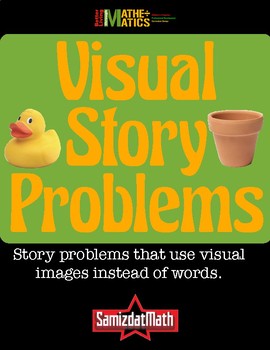Visual Problem Solving For Struggling Readers: 3rd - 5th grade
SamizdatMath
802 Followers
Description
Greetings Phrens,
This is an experiment for a third grade teacher who is struggling to engage two dyslexic students in the process of answering mathematical story problems. She showed me a set of story problems and described how a teacher had to sit next to the students and read the problems to the students, who then solved them.
I thought about this and stated that this seemed like a very hard way to engage these students in problem solving, because the task was really more focused on reading and decoding, which meant they were really spending their time less on math and more on just figuring out the meaning of the individual words. That is, they were using 90% of their time to decode and comprehend, while using only 10% of the time to do actual math!
So this is what resulted: 2 sets of problems using similar contexts (seeds and pots, ducks and boxes.) I decided that switching to different subjects would be distracting, so I decided as a way to simplify the problems to just use the same context over and over, which required the students to focus on using mathematics to answer the question.
Since these studens are dyslexic, I made it so the problems could be solved with a minimal number of numbers, while still being tricky; the “trickiness” comes in the form of “interleaving,” which means the problems use all four operations and are specifically designed to avoid the use of those ridiculous “target words,” or whatever they call them - you know, like “difference,” “sum,” “altogether,” and “each?” I hate that stuff because students forget about the problem and just look for individual words instead of the entire meaning.
So what happened? The students really liked working on these problems, because they didn’t have to spend their entire time reading sentences and decoding the words individually. They enjoyed that the problems were straightforward, but still challenging, and that while in the past for every one or two problems they solved the others had solved 5 or 6, they could solve the same number of problems as the other kids in the class. A class win-win-win situation!
Try these out on your struggling readers and see what they think! If they work well, please tell me and I’ll make a lot more! As I said, this was an experiment which worked with my kids, but who knows, your results may differ....
This is an experiment for a third grade teacher who is struggling to engage two dyslexic students in the process of answering mathematical story problems. She showed me a set of story problems and described how a teacher had to sit next to the students and read the problems to the students, who then solved them.
I thought about this and stated that this seemed like a very hard way to engage these students in problem solving, because the task was really more focused on reading and decoding, which meant they were really spending their time less on math and more on just figuring out the meaning of the individual words. That is, they were using 90% of their time to decode and comprehend, while using only 10% of the time to do actual math!
So this is what resulted: 2 sets of problems using similar contexts (seeds and pots, ducks and boxes.) I decided that switching to different subjects would be distracting, so I decided as a way to simplify the problems to just use the same context over and over, which required the students to focus on using mathematics to answer the question.
Since these studens are dyslexic, I made it so the problems could be solved with a minimal number of numbers, while still being tricky; the “trickiness” comes in the form of “interleaving,” which means the problems use all four operations and are specifically designed to avoid the use of those ridiculous “target words,” or whatever they call them - you know, like “difference,” “sum,” “altogether,” and “each?” I hate that stuff because students forget about the problem and just look for individual words instead of the entire meaning.
So what happened? The students really liked working on these problems, because they didn’t have to spend their entire time reading sentences and decoding the words individually. They enjoyed that the problems were straightforward, but still challenging, and that while in the past for every one or two problems they solved the others had solved 5 or 6, they could solve the same number of problems as the other kids in the class. A class win-win-win situation!
Try these out on your struggling readers and see what they think! If they work well, please tell me and I’ll make a lot more! As I said, this was an experiment which worked with my kids, but who knows, your results may differ....
Total Pages
10 pages
Answer Key
Included
Teaching Duration
N/A
Report this resource to TPT
Reported resources will be reviewed by our team. Report this resource to let us know if this resource violates TPT’s content guidelines.





